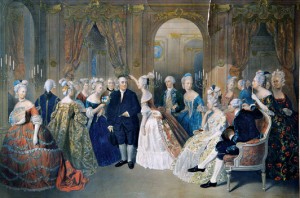Today when you think about salons, you probably think about places people go to have their hair polished and styled for a price. However this is not the case for what salons were in the 17th and 18th centuries.
Early French salons served as a sort of haven for exchanging and receiving information. Though salons were more than just a place for the exchange of information. During the 17th and 18th centuries, France was still under much male dominance. Salons served as a place for women to escape the tight structuring of French society, and seek out a place of freedom. Salons were a place where French women could not only show off their beauty and seduce others, but a place where they could also boast their intellectuality.
According to the New York Times, France at this time was in an era of absolutism. Salons created a hideaway where ideas could be discussed freely without the control of the royal court. And of course, men were drawn to the salons, not only because of availability of mistresses, and women coming from nobility’s cleverest and most beautiful, but because they could talk politics without a risk.
Much credit for the origin of salons goes to Catherine de Vivonne, most well-known as Madame de Rambouillet. She was the host of hôtel de Rambouillet, her own home; a place where in the famous Blue room, nobility’s right to have a private life and live in social coexistence was protected.
Naturally because salons were created by the women, they were also centered around the women. Alpha History says that initially in the 17th century, the main purpose of salons was to provide the opportunity for news, gossip, and information to be exchanged freely between women and men. In the 18th century, the purpose of salons matured into something more. Salons became a place for women to put their etiquette to practice while also creating a more formalized structure for women to expand their education and intellectual knowledge. The 18th century provided a time for all the information being exchanged to be debated within this safe haven, so that both women and men had a sense of outlines for arguments, debating, and plotting on information to bring outside the salons.
A book called “The Age of Conversation” by Benedetta Craveri translated by Teresa Waugh for the New York Times presented a quote: “High society women took it upon themselves to educate the men.” This means that the women were in charge. They set the rules for salons and showed men that they could be much more than their appearance of beauty.


Leave a response